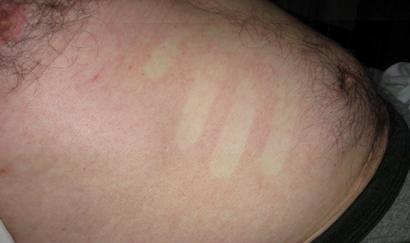Port Melbourne VFL player Sam O’Sullivan is reportedly recovering in hospital after being infected with the flesh-eating disease “necrotising myositis”. This disease is one of a group of serious infections affecting soft tissue, usually called “necrotising fasciitis” or sometimes “gas gangrene”.
Like many medical terms, necrotising fasciitis is simply a descriptor. Breaking this down into its parts, it is inflammation (“-itis”) due to an infection of the fascia (the lining between the skin and the underlying muscles) that causes death of the tissues (necrosis).
The key concept here is the body structures that are affected. Those infections that affect the skin and superficial tissues, termed “cellulitis”, are generally mild.
But when they affect the deeper fascia and muscles (“myositis”), they can spread very quickly and cause severe illness. Because the action is occurring at a deeper level, there may be few or no changes to see on the surface.
Major complications of necrotising fasciitis include extensive loss of skin or deeper tissue (sometimes resulting in loss of the limb), and severe stress on the body’s organs (resulting in organ failure). For a rather graphic example of skin damage, click here.
Around a quarter of patients with necrotising fasciitis will die of their infection, but this varies with the severity of the infection and the underlying health of the patient.
What causes it?
Necrotising fasciitis is caused by bacteria that gain access to the body, usually by damage to the skin, the first line of protection.
Quite a few different types of bacteria can cause the disease. However, when they cause infection elsewhere, many are only associated with mild disease. These include group A streptococci, a common cause of tonsillitis, and Clostridium perfringens, a cause of food poisoning.
Contrary to many news reports, it is not caused by viruses – there is no flesh-eating virus.
Around 400 cases of necrotising fasciitis are diagnosed in Australian hospitals each year, which is similar to the incidence reported in other countries.
How is it contracted?
As with many infectious diseases, three factors interact to produce an infection: factors related to the bacteria; factors related to the patient; and factors relating to the environment that brings them together – in this case, the nature of the injury.
Patient factors associated with infection include impaired immunity, obesity and chronic diseases such as diabetes.
Many patients report a preceding breach in the skin, through things such as surgery, accidental wounds, or intravenous drug use.
Some types of infections are associated with particular settings. For instance, injuries occurring in marine environments, such as coral cuts, can be associated with particular types of bacteria that live in watery settings (such as Vibrio or Aeromonas).
Similarly, severe infections associated with intravenous drug use may be due to contamination of the injected substances.
In the past, gas gangrene was a common complication of battlefield injury, as wounds were often contaminated with dirt and there were delays to surgical treatment and access to antibiotics, if these were available at all.
Some strains of bacteria produce toxins that can enable them to spread readily through tissue. Group A streptococci, for instance, produce a toxin called cysteine protease SpeB, which may allow the bacteria to dissolve tissue and evade the immune system.
Group A streptococci also produce a range of other toxins but their role and function are not well understood.
How is it recognised?
Unfortunately, early necrotising fasciitis is easily missed. This is because the symptoms – fever, pain, swelling and tenderness at the affected site – may be non-specific or confused with a mild, superficial infection.
The hallmark of necrotising fasciitis is pain far more severe than expected for what might otherwise look like a minor infection. As the infection progresses, the skin becomes tense and discoloured, and patients may become severely unwell with low blood pressure and confusion.
Occasionally, some bacteria produce gas and this can be felt as “crackling” under the skin. The infection can spread quickly – over minutes to hours – and deaths have been described within 24 hours in otherwise healthy people.
How is it treated?
The most important treatment for infections such as necrotising fasciitis or myositis is surgery to remove the dead tissue and as much of the bacterial burden as is possible.
The decision to operate involves careful clinical judgement – not every skin infection needs surgery and clearly no-one wants surgery for an otherwise simple infection. However, if necrotising fasciitis is truly present, early surgery can be life-saving. In some cases, surgery may result in amputation or require extensive skin grafting.
A combination of different antibiotics is usually used. A range of different bacteria may be implicated and each requires different antibiotics. Some antibiotics may also help switch off the toxins produced by bacteria.
There is some interest in other secondary treatments, though these should be considered only after getting the patient to surgery, supporting failing organ systems and quickly administering the correct antibiotics. Hyperbaric oxygen delivered in specialised compression chambers, for instance, aims to preserve living tissue and help the immune system combat infection. However, there is little good evidence that this helps.
Similarly, intravenous immunoglobulin is a serum protein pooled from blood donors that may “mop up” toxin. It is sometimes given for some types of necrotising fasciitis, although the evidence that it helps is also conflicting.![]()
This article was originally published on The Conversation. Read the original article.
Photo: Group A Streptococcus bacteria. NIAID/Fickr
Other doctorportal blogs
- ‘As an Aboriginal doctor, you bring a unique approach to medicine’
- Sharing the experience of grief from a doctor’s perspective
- We’re overdosing on medicine – it’s time to embrace life’s uncertainty

 more_vert
more_vert